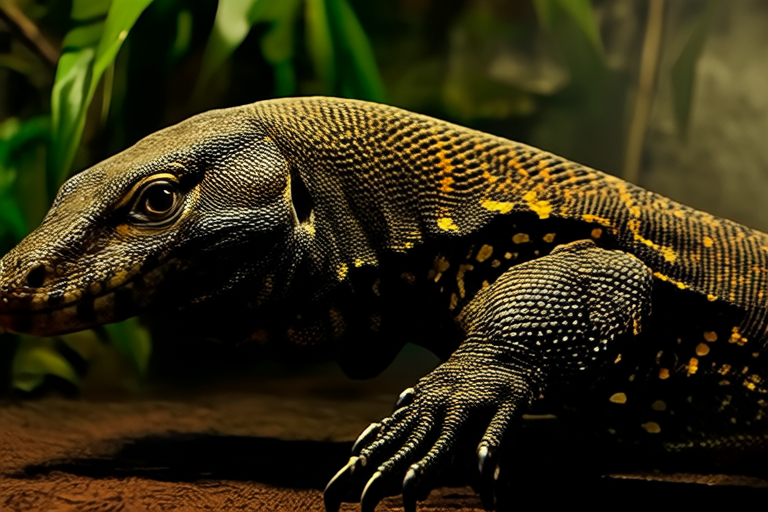From Jungle to Home: Everything You Need to Know About Keeping a Water Monitor as a Pet
Water monitors (Varanus salvator) are among the largest lizards in the world, native to Southeast Asia. Their striking appearance, combined with their impressive size and agility, makes them fascinating creatures for experienced reptile enthusiasts. However, due to their demanding care requirements and the significant responsibility involved, water monitors are not suitable pets for beginners. This article will guide you through everything you need to know about keeping a water monitor as a pet, from understanding their unique characteristics to providing optimal care.
Unique Characteristics and Why They Make Interesting Pets
Water monitors possess several unique traits that set them apart from other reptiles. These semi-aquatic lizards are adept swimmers and climbers, capable of diving up to 45 meters deep and staying submerged for over an hour. Their powerful tails assist in swimming, while their claws help them climb trees and dig burrows. Water monitors also have excellent eyesight and a keen sense of smell, which they use to locate prey.
For experienced reptile owners, water monitors can be captivating pets. Their intelligence, curiosity, and adaptability make them enjoyable to interact with. However, it’s crucial to recognize that these animals require a substantial investment of time, resources, and knowledge to ensure their well-being.
Habitat Requirements
Enclosure Size
Adequate space is essential for the physical and psychological well-being of a water monitor. The minimum recommended enclosure size for an adult water monitor is approximately 8 feet long, 4 feet wide, and 6 feet tall. Larger enclosures are preferable to allow the lizard ample room to move around, swim, and climb. Providing multiple branches, rocks, and hiding spots within the enclosure will enrich the environment and promote natural behaviors.
Temperature Gradients
Water monitors are ectothermic, meaning they rely on external heat sources to regulate their body temperature. Maintaining a proper temperature gradient is vital for their digestion, metabolism, and overall health. A basking area with temperatures between 95-100°F (35-38°C) should be provided, alongside a cooler area ranging from 75-85°F (24-29°C). Nighttime temperatures can drop slightly, but never below 70°F (21°C).
Lighting
Proper lighting is crucial for maintaining your water monitor’s health. UVB lighting simulates natural sunlight, promoting calcium absorption and preventing metabolic bone disease. Full-spectrum fluorescent bulbs emitting UVB radiation should be placed above the basking area. Additionally, a heat lamp or ceramic heat emitter can provide the necessary warmth.
Humidity Levels
Maintaining appropriate humidity levels is critical for water monitors, as they originate from tropical environments. Humidity should be kept between 70-80%, which can be achieved by misting the enclosure daily and incorporating a large water dish. A hygrometer can help monitor humidity levels accurately.
Diet and Feeding Frequency
Water monitors are carnivorous and have diverse dietary preferences. In captivity, their diet should consist primarily of rodents, insects, fish, and occasionally eggs. Juvenile water monitors may eat more insects and smaller prey items, while adults can consume larger prey such as mice, rats, and even small rabbits.
Feeding frequency varies depending on the age and size of the lizard. Younger water monitors may need to be fed daily, whereas adults can be fed every 3-4 days. It’s important to offer a varied diet to ensure proper nutrition and prevent obesity.
Common Health Issues, Signs of Illness, and Preventive Care Measures
Despite their hardiness, water monitors can still face various health issues. Common problems include metabolic bone disease, respiratory infections, and parasites. Signs of illness may include lethargy, loss of appetite, unusual discharge, or abnormal behavior. Regular veterinary check-ups, a balanced diet, and a clean, well-maintained enclosure are essential for preventing and addressing health concerns.
To maintain optimal health, water monitors should receive routine veterinary care, including fecal exams and blood tests. Quarantine new additions to the enclosure for at least 30 days to prevent the spread of diseases. Proper hygiene practices, such as regular cleaning and disinfecting of the enclosure, also contribute to a healthy living environment.
Handling, Socialization, and Legal Considerations
Handling
Water monitors can be skittish and defensive, especially when young. Handling should be done gently and infrequently, allowing the lizard to acclimate to its surroundings first. Always approach from the side or front, avoiding sudden movements. Never handle a water monitor by the tail, as this can cause injury.
Socialization
Water monitors are solitary animals in the wild and generally do not require companionship. Housing multiple water monitors together is not recommended, as it can lead to territorial disputes and stress.
Legal Considerations
Prior to acquiring a water monitor, research local regulations regarding exotic pet ownership. Some areas prohibit or restrict the keeping of certain species, including water monitors. Obtaining the necessary permits and licenses may be required. Additionally, consider the ethical implications of keeping a wild animal in captivity.
Commitment and Resources for Further Learning
Owning a water monitor is a significant commitment that requires dedication, patience, and continuous learning. Potential owners must be prepared to invest time and money into providing an appropriate environment, diet, and healthcare. Resources for further learning include books, online forums, and reptile expos. Engaging with experienced reptile enthusiasts and attending workshops can also enhance your knowledge and skills.
In conclusion, water monitors are magnificent creatures that can thrive in captivity when provided with proper care and attention. By understanding their unique characteristics, habitat requirements, dietary needs, and health considerations, you can ensure a rewarding experience for both you and your pet. Remember, responsible ownership is key to maintaining the well-being of these remarkable reptiles.
